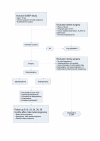The ESEP study: salpingostomy versus salpingectomy for tubal ectopic pregnancy; the impact on future fertility: a randomised controlled trial
- PMID: 18582372
- PMCID: PMC2464580
- DOI: 10.1186/1472-6874-8-11
The ESEP study: salpingostomy versus salpingectomy for tubal ectopic pregnancy; the impact on future fertility: a randomised controlled trial
Abstract
Background: For most tubal ectopic pregnancies (EP) surgery is the treatment of first choice. Whether surgical treatment should be performed conservatively (salpingostomy) or radically (salpingectomy) in women wishing to preserve their reproductive capacity, is subject to debate. Salpingostomy preserves the tube, but bears the risks of both persistent trophoblast and repeat ipsilateral tubal EP. Salpingectomy, avoids these risks, but leaves only one tube for reproductive capacity. This study aims to reveal the trade-off between both surgical options: whether the potential advantage of salpingostomy, i.e. a better fertility prognosis as compared to salpingectomy, outweighs the potential disadvantages, i.e. persistent trophoblast and an increased risk for a repeat EP.
Methods/design: International multi centre randomised controlled trial comparing salpingostomy versus salpingectomy in women with a tubal EP without contra lateral tubal pathology. Hemodynamically stable women with a presumptive diagnosis of tubal EP, scheduled for surgery, are eligible for inclusion. Patients pregnant after in vitro fertilisation (IVF) and/or known documented tubal pathology are excluded. At surgery, a tubal EP must be confirmed. Only women with a tubal EP amenable to both interventions and a healthy contra lateral tube are included. Salpingostomy and salpingectomy are performed according to standard procedures of participating hospitals. Up to 36 months after surgery, women will be contacted to assess their fertility status at six months intervals starting form the day of the operation. The primary outcome measure is the occurrence of spontaneous viable intra uterine pregnancy. Secondary outcome measures are persistent trophoblast, repeat EP, all pregnancies including those resulting from IVF and financial costs. The analysis will be performed according to the intention to treat principle. A cost-effectiveness analysis will be performed within a decision analysis framework, based on costs per live birth, including IVF treatment whenever a spontaneous pregnancy does not occur. Patients' preferences will be assessed using a discrete choice experiment.
Discussion: This trial will provide evidence on the trade off between salpingostomy and salpingectomy for tubal EP in view of the pros and cons of both interventions and will offer guidance to clinicians in making the right treatment choice.
Trial registration: Current Controlled Trials ISRCTN37002267.
References
-
- Stromme WB, McKelvey JL, Adkins CD. Conservative surgery for ectopic pregnancy. Obstet Gynecol. 1962;19:294–301. - PubMed
-
- Royal College of Obstetricians and Gynaecologists . Guideline No 21. RCOG Press; 2004. The management of ectopic pregnancy.
Publication types
MeSH terms
Associated data
LinkOut - more resources
Full Text Sources
Miscellaneous


